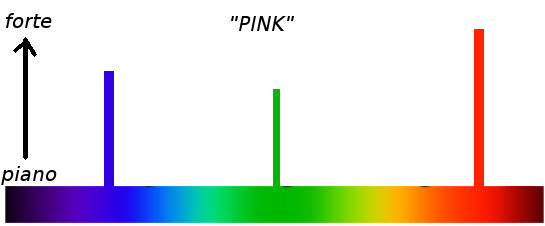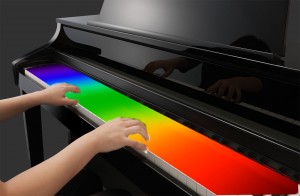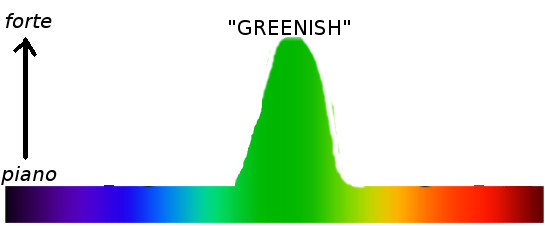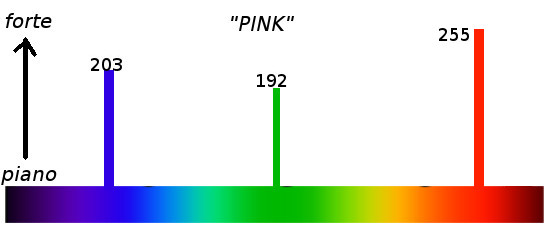The Colors of the Rainbow, Part I: The Infinite Piano

The phrase “All the colors of the rainbow” is often used to refer to every imaginable color that you can see. What is interesting is that almost the exact opposite is true: With the exception of the rainbow itself, you almost never see the colors of the rainbow in nature, and indeed almost all of the colors that you do see are NOT in the rainbow.
Look closely at the rainbow spectrum above. Try to find Pink. Or Brown. Or Teal. Or Chartreuse, Mauve, Vermillion, etc etc… You won’t and you can’t. So what’s going on?
Think of it this way: picture the rainbow spectrum above stretched out over the keys of a piano. But not just any piano will do, and 88 keys are nowhere near enough. You will need a piano where the keys are infinitely thin, and there are an infinite number of keys, so the keyboard looks like this:
So the idea is, each color in the rainbow is just a single (very thin) key, a single note on the piano, and as you run your finger along the piano, playing a glissando, you are really just playing just one note at a time. But in our world, the colors that we see are each a chord, made up of many of these keys played together. You will need a lot of fingers, and a hand-reach far beyond that of even Rachmaninov, covering the entire piano for some colors.
And it has to be a real piano, not just a harpsichord where strings a plucked. Remember, the reason a piano is called a piano is that you can play each note soft or loud (piano e forte = soft and loud), depending on how hard you hit the key or step on a pedal. So, in the real world, if you see a green leaf, for example, most likely what is being “played” is a very strong solid GREEN fortissimo note, with millions of close “greenish” unison notes nearby but more pianissimo, kind of like this:
Just to explore this piano metaphor a bit further, we should note that light is a wave just like sound, and has specific frequencies and wavelengths. But one difference is that we can hear a very wide range of frequencies of sound, across roughly ten octaves. Since the speed of sound and light are so different, let’s put it in terms of wavelengths. Each octave is half the wavelength of the previous one, and so for sound the range of wavelengths goes from 17 meters (low pitch 20 Hertz) to 1.7 cm (20,000 Hertz). The standard piano covers about seven of those musical octaves. By comparison, the wavelengths of light we can see go from deep red, about 700 nanometers (billionths of a meter), to deep violet, about 400 nanometers. In other words, the color/light piano usable to humans is just short of covering a single octave of light. Not much opportunity for harmonizing, although some shades of violet could be a perfect fifth above deep red.
(I should apologize for one mistake in my piano picture: to make the analogy exact, the RED should be at the left, as it is a deep low-frequency bass, while violet should be at the right, a high-frequency treble. So let’s call this a left-handed piano get on with life.)
So where are all of our more familiar colors located? Some of them are fairly complicated chords. For example, you might play a RED note loudly, a GREEN note softer, and a BLUE note just a bit more strongly … and if you did, the name of that chord is — guess what? — PINK.
The “sheet music” for this single 3-note chord composition could be written out over the keyboard with three vertical bars, each indicating the loudness or softness of each of the three keys we need to play, like this:
We could even assign numbers to each of these loudness values, say, from 0 being absolute quiet (ie, don’t touch the key), to 255 being the LOUDEST you can hit the key. In the case of “PINK”, it would look something like this:
We could even shorten this musical notation by saying (R,G,B) = (255, 192, 203). Now you may think that I just made up those particular numbers, but in fact if you check with Wikipedia, the internet standard for color on computer displays has exactly these three values for the color pink.
So, the take-away from this first part of my blog is that the universe of color is much larger than the single keys on the rainbow piano. You’ve got to play chords. But even then it gets complicated, and more interesting, which we’ll see in part two, “Yellow is An Idea“.



